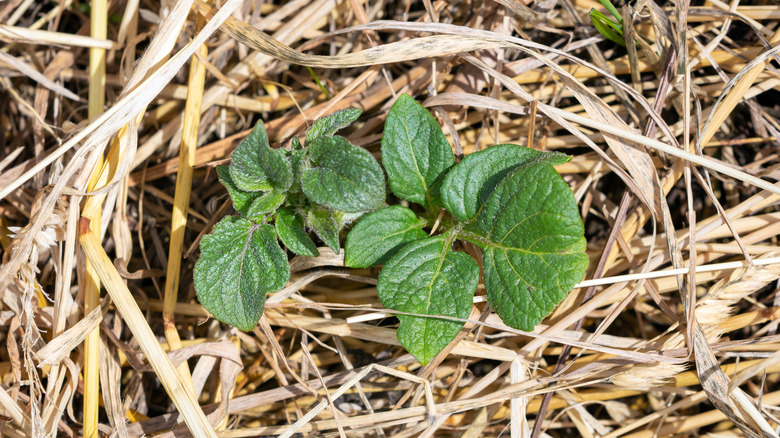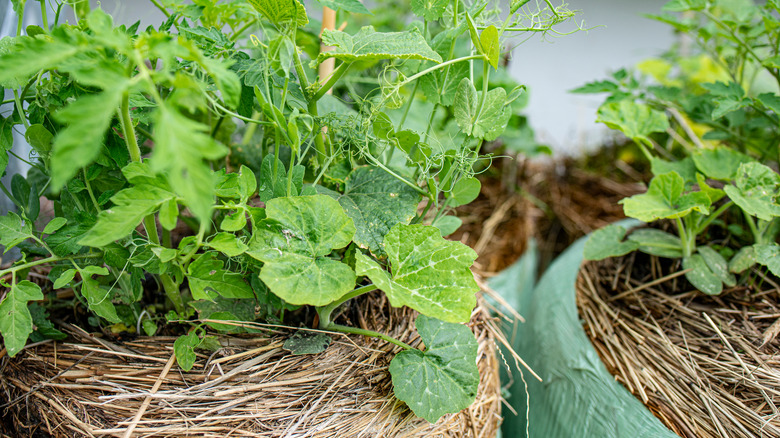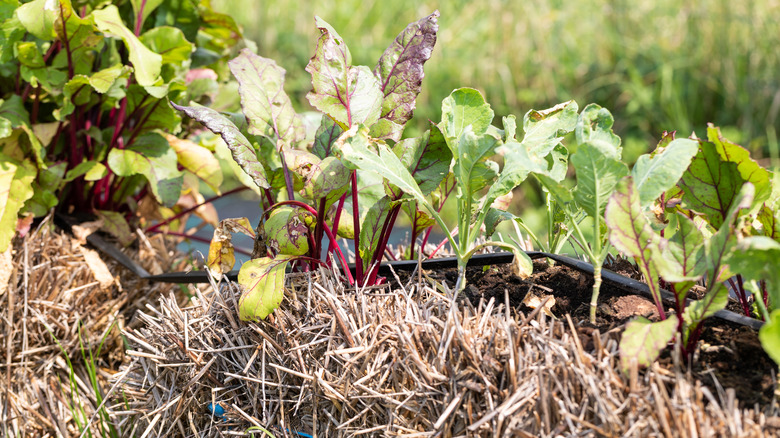What Is Straw Bale Gardening And How To Implement It In Your Outdoor Space
These days, you don't need to own a massive house with a large backyard to produce a fruitful garden. Alternative cultivation methods are trending as people in smaller spaces or with disabilities seek new ways to grow food. Straw bale gardening is one such technique that is currently gaining traction due to its low cost, alluring simplicity, and accessibility. This contained gardening hack uses bales of straw as the plant's bed rather than soil.
With straw bale gardening, you can grow fruits and vegetables on patios, balconies, concrete, and apartment rooftops — wherever your heart desires. In addition, utilizing straw bales eliminates the manual labor of preparing the ground each season and the threat of invasive weeds, unwanted pests, and soilborne diseases. At present, healthy foods like strawberries, apples, spinach, kale, bell peppers, and more are often coated with pesticides, preservatives, and other chemicals by the time they're purchased. Thankfully, this unconventional growing method allows us to plant organic gardens wherever possible and avoid store-bought produce in many cases.
What is straw bale gardening?
With straw bale gardening, you can eliminate many of the headaches that come with soil-grown plants by using just a bundle of straw. These bales are conditioned to provide nutrients by thoroughly watering and adding fertilizers or other nitrogen sources like manure and seed meals. This combination allows the grain to start composting, releasing heat and supplements as it breaks down, eventually nurturing your plants for healthy growth.
Bales of straw are great for roots as they offer many openings and crevices they can snake through. Some of the most successful plants for this form of gardening include tomatoes, cucumbers, and peppers. Vegetables like kale and lettuce face substantially less risk in terms of pest damage as you eliminate soil, and fruit such as strawberries that require substantial drainage will thrive. Herbs and flowers can also be grown successfully with this method. Your straw can eventually go into a compost pile or be used as mulch, bringing your garden full circle. However, remember the difference between straw and hay when you go out to buy your bales: Hay is used for feeding livestock and often contains Timothy and alfalfa seeds, which will grow alongside your seedlings.
Adding straw bale gardens to outdoor spaces
You can buy your bales from nurseries, garden stores, and local farms, but remember to avoid bundles treated with commercial fertilizer if you don't want those chemicals mingling with your plants. Next, choose a permanent location for your garden. While it is possible to move straw bales around, they can get heavy and become a hassle to transport. Along with your straw, you'll need organic fertilizer or another nitrogen source, a hand towel or gloves for creating your seed divots, and a trellis if you plan on growing climbing plants.
Implementing a straw bale garden may require less work than a soil-based garden, but it will still require persistence. Begin by encouraging your bale to compost by applying fertilizer and soaking well. Dispersing fertilizer and giving it one good watering a day for approximately a week will be sufficient and ensure you don't overwater and wash out nutrients. You can plant your seeds immediately after the conditioning period. Smaller seeds are recommended to be buried one-fourth inch deep, and larger seeds further down but still close to the surface. Water daily when it doesn't rain and fertilize once every few weeks until the plants mature, then increase to once a week. Before you know it, you'll be harvesting your own fruit and vegetables at home.


